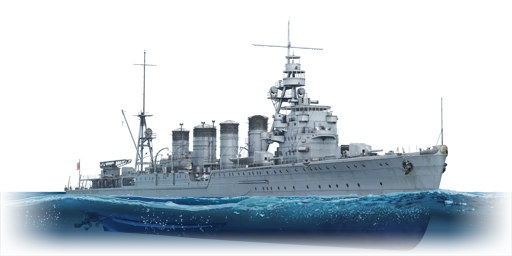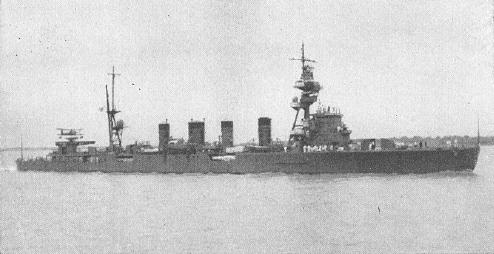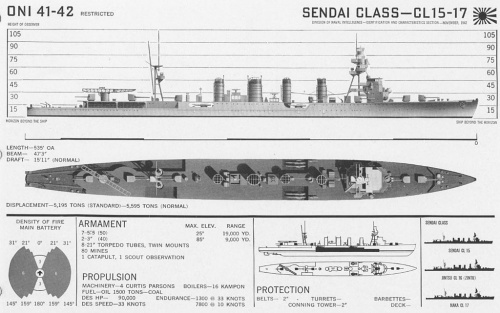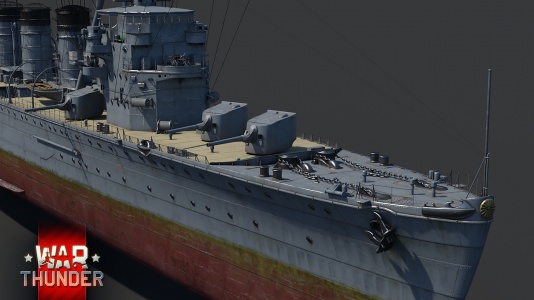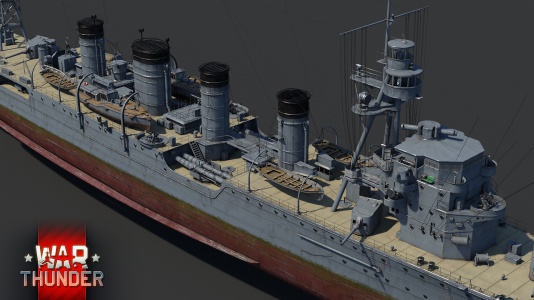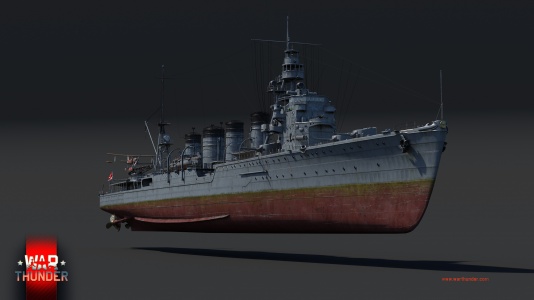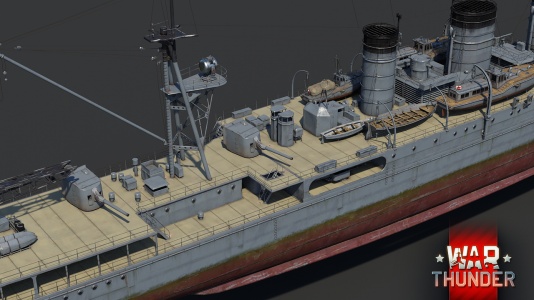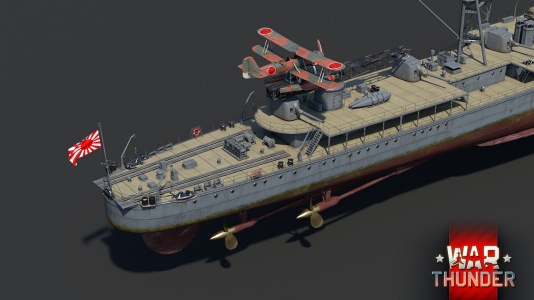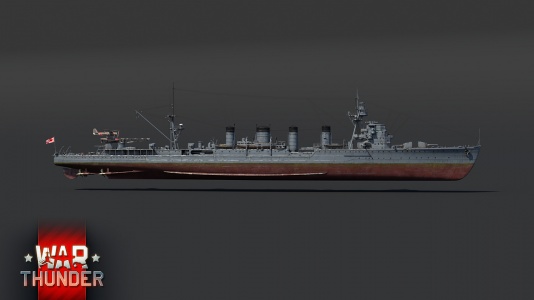Difference between revisions of "IJN Sendai"
(→Scout plane) |
m (Removed non-existent image) |
||
| (3 intermediate revisions by 3 users not shown) | |||
| Line 7: | Line 7: | ||
<!-- ''In the first part of the description, cover the history of the ship's creation and military application. In the second part, tell the reader about using this ship in the game. Add a screenshot: if a beginner player has a hard time remembering vehicles by name, a picture will help them identify the ship in question.'' --> | <!-- ''In the first part of the description, cover the history of the ship's creation and military application. In the second part, tell the reader about using this ship in the game. Add a screenshot: if a beginner player has a hard time remembering vehicles by name, a picture will help them identify the ship in question.'' --> | ||
The '''{{Specs|name}}''' (川内, [[Abbreviations#.28JP.29_Naval|namesake]]: Sendai River) is a rank {{Specs|rank}} Japanese light cruiser {{Battle-rating}}. It was introduced in [[Update 1.95 "Northern Wind"]]. | The '''{{Specs|name}}''' (川内, [[Abbreviations#.28JP.29_Naval|namesake]]: Sendai River) is a rank {{Specs|rank}} Japanese light cruiser {{Battle-rating}}. It was introduced in [[Update 1.95 "Northern Wind"]]. | ||
| + | |||
| + | The Sendai-class cruisers were named after rivers, and IJN Sendai specifically took its name from the Sendai River in southern Kyūshū. It was intended to serve as the flagship of a destroyer flotilla. The other two cruisers in the Sendai class were the IJN Naka (Named after the Naka River in Kyūshū, Japa) and the IJN Jintsū (Named after the Jinzu River in Japan) | ||
== General info == | == General info == | ||
| Line 29: | Line 31: | ||
''Provide information about the characteristics of the primary armament. Evaluate their efficacy in battle based on their reload speed, ballistics and the capacity of their shells. Add a link to the main article about the weapon: <code><nowiki>{{main|Weapon name (calibre)}}</nowiki></code>. Broadly describe the ammunition available for the primary armament, and provide recommendations on how to use it and which ammunition to choose.'' | ''Provide information about the characteristics of the primary armament. Evaluate their efficacy in battle based on their reload speed, ballistics and the capacity of their shells. Add a link to the main article about the weapon: <code><nowiki>{{main|Weapon name (calibre)}}</nowiki></code>. Broadly describe the ammunition available for the primary armament, and provide recommendations on how to use it and which ammunition to choose.'' | ||
| − | + | {{:140 mm/50 3rd Year Type (140 mm)/Ammunition|140 mm type 0 HE, 140 mm type 2 SAP, 140 mm type 0 HE-TF, 140 mm mod 1 SAP}} | |
=== Secondary armament === | === Secondary armament === | ||
{{Specs-Fleet-Secondary}} | {{Specs-Fleet-Secondary}} | ||
| Line 54: | Line 56: | ||
== Usage in battles == | == Usage in battles == | ||
| − | ' | + | It's a pretty fast ship. It is recommended to use it on the back of the maps, avoiding being the point of attention. Coastal boat capture points can be reached under certain game conditions, but if it is done, the costal boats will usually attack with torpedoes and the ship will be sunk. |
| + | |||
| + | ''In case of fire, flooding and repairs, prioritize putting out the fire before any other damage, as the fire kills the crew very quickly.'' | ||
| + | |||
| + | It is more efficient to use the boat at about 35° or 40° with respect to its transverse axis (Bow – Stern), since the possibility of receiving impacts that generate fires or floods can be minimized. | ||
| + | |||
| + | It is not advisable to fight coastal boats at close range because the anti-aircraft defense does not have the capacity or the depression to fire downwards and neither do the main guns. | ||
| + | |||
| + | It is always preferable to attack from a long distance and not become the center of attention because as soon as they start to catch fire and have to repair breaches, crisis management is not going to be good, and it will be reduced in a brief time. | ||
| + | |||
| + | Even with the improved distance measurement, projectiles tend to impact beyond the target, therefore, it is recommended to aim a little “below” the targets. | ||
=== Pros and cons === | === Pros and cons === | ||
| Line 61: | Line 73: | ||
'''Pros:''' | '''Pros:''' | ||
| − | * | + | * It's a pretty fast ship. |
| − | * Turrets are placed along whole ship which makes them hard to disable | + | * Turrets are placed along whole ship which makes them hard to disable. |
| − | * SAPBC | + | * Its first ammo type, high explosive, is quite good against Destroyers. It is functional if used against Cruisers, seeking to set them on fire, however it is not ideal for confronting large ships directly. |
| + | * The second type of bullet, SAPBC, is quite good for more heavily armored ships since it can generate ammunition explosions by penetrating the hull more efficiently. This ammunition does not generate surface fires as frequently but allows you to disable turrets. | ||
* 16 long range torpedoes (with torpedo modification) | * 16 long range torpedoes (with torpedo modification) | ||
| − | * | + | * When the crew is above 70%, putting out fires is quite simple. |
| + | * In realistic battles you can survive a flooded compartment (usually from a torpedo hit). | ||
'''Cons:''' | '''Cons:''' | ||
| − | * | + | * His command post is very exposed. These catches fire very easily which causes the boat to lose the ability to steer and change speed. |
| − | * | + | * Almost all of her crew compartments were located on the deck, making them extremely vulnerable to HE shells. The ship catches fire very quickly. |
| − | * Can't release all torpedoes to one side | + | * Its anti-aircraft weapons are considerably basic. Defending against planes will be very difficult. Defending against coastal ships will be almost impossible. They have no cover or view towards the back of the boat. |
| + | * Can't release all torpedoes to one side. | ||
== History == | == History == | ||
<!-- ''Describe the history of the creation and combat usage of the ship in more detail than in the introduction. If the historical reference turns out to be too long, take it to a separate article, taking a link to the article about the ship and adding a block "/History" (example: <nowiki>https://wiki.warthunder.com/(Ship-name)/History</nowiki>) and add a link to it here using the <code>main</code> template. Be sure to reference text and sources by using <code><nowiki><ref></ref></nowiki></code>, as well as adding them at the end of the article with <code><nowiki><references /></nowiki></code>. This section may also include the ship's dev blog entry (if applicable) and the in-game encyclopedia description (under <code><nowiki>=== In-game description ===</nowiki></code>, also if applicable).'' --> | <!-- ''Describe the history of the creation and combat usage of the ship in more detail than in the introduction. If the historical reference turns out to be too long, take it to a separate article, taking a link to the article about the ship and adding a block "/History" (example: <nowiki>https://wiki.warthunder.com/(Ship-name)/History</nowiki>) and add a link to it here using the <code>main</code> template. Be sure to reference text and sources by using <code><nowiki><ref></ref></nowiki></code>, as well as adding them at the end of the article with <code><nowiki><references /></nowiki></code>. This section may also include the ship's dev blog entry (if applicable) and the in-game encyclopedia description (under <code><nowiki>=== In-game description ===</nowiki></code>, also if applicable).'' --> | ||
| − | [[File:IJN Sendai.jpg|thumb| | + | [[File:IJN Sendai.jpg|thumb|494x494px|IJN Sendai, date unknown. Note the seaplane and catapult mounted above her rear guns.]] |
| − | IJN Sendai was the lead ship of the ''Sendai'' class, a class of three light cruisers built for the Imperial Japanese Navy following the end of World War 1. Designed to serve as leaders of destroyer flotillas, the ships were built in the early 1920s. ''Sendai'' saw service during the second Sino-Japanese war, and later served as the flagship of Destroyer Squadron 3 during the Second World War. She participated in numerous conflicts including the Battles of Guadalcanal, and was sunk during the Battle of Empress Augusta | + | IJN Sendai was the lead ship of the ''Sendai'' class, a class of three light cruisers built for the Imperial Japanese Navy following the end of World War 1. Designed to serve as leaders of destroyer flotillas, the ships were built in the early 1920s. |
| + | |||
| + | ''Sendai'' saw service during the second Sino-Japanese war, and later served as the flagship of Destroyer Squadron 3 during the Second World War. | ||
| + | |||
| + | She participated in numerous conflicts including the Battles of Guadalcanal, and was sunk during the Battle of Empress Augusta Bay, having been critically damaged by American light cruisers. | ||
| + | |||
| + | '''Service Career''' | ||
| + | |||
| + | * Completed at the Mitsubishi Nagasaki shipyards on '''29 April 1924'''. | ||
| + | * Initially assigned to Yangtze River patrol in China. | ||
| + | * Played a crucial role in the '''Battle of Shanghai''' during the early stages of the '''Second Sino-Japanese War'''. | ||
| + | * Covered the landings of Japanese forces in southern China. | ||
| + | * Became the flagship of '''Destroyer Squadron 3''' under Rear Admiral Shintaro Hashimoto during the '''Japanese Invasion of Malaya'''. | ||
| + | * Engaged in escorting transports carrying Lieutenant General Tomoyuki Yamashita and the Japanese 25th Army for the invasion of Malaya. | ||
| + | * Participated in the bombardment of Kota Bharu, Malaya. | ||
| + | * Sunk on '''3 November 1943''' by United States Navy cruisers during the '''Battle of Empress Augusta Bay''' in the Solomon Sea. | ||
'''Design and development''' | '''Design and development''' | ||
| + | The Sendai-class cruisers were a class of three light cruisers, built as a follow-up to the previous Nagara class. As destroyer flotilla flagships, they were essentially enlarged destroyers, and displaced just 5,500 tons full. ''Sendai'' was armed with seven 140 mm (5.5 inch) guns, mounted in single mounts. The turrets were mounted in an unusual arrangement, with two guns fore, two guns on either side of the bridge, and three guns aft. ''Sendai's'' secondary and anti-aircraft suite was extremely sparse, with several 25 mm and 13.2 mm guns. ''Sendai'', similar to the previous ''Nagara'' class, carried sixteen 610 mm "Long Lance" torpedoes, with four dual launchers and eight reloads. | ||
| + | |||
| + | * '''Armament''': | ||
| + | ** 7 × 140 mm (5.5 in)/50 guns (7x1) | ||
| + | ** 2 × 80 mm (3 in)/40 anti-aircraft guns | ||
| + | ** 4 × 610 mm (24 in) torpedo tubes (2x2) | ||
| + | ** 48 × mines | ||
| + | |||
| + | [[File:ONI depiction of the class.jpg|thumb|500x500px|''[https://naval-encyclopedia.com/ww2/japan/sendai-class-cruisers.php ONI depiction of the class]'']] | ||
| + | Her top speed was 35.3 knots (65.4 km/h; 40.6 mph), extremely fast for a cruiser. This allowed ''Sendai'' to maintain speed with the destroyers that she would command. She was also able to carry a reconnaissance seaplane, being fitted with a catapult and seaplane recovery facilities. | ||
| − | + | ''Sendai'' was ordered in the early 1920s and completed by April 1924. Before the outbreak of war, she served extensively in the East China Sea, and participated in the second Sino-Japanese war. | |
| − | '' | + | * '''Displacement''': 5,195 long tons (5,278 t) (standard) |
| + | * '''Length''': 152.4 meters (500 feet) | ||
| + | * '''Beam''': 14.2 meters (46 feet 7 inches) | ||
| + | * '''Draft''': 4.9 meters (16 feet 1 inch) | ||
| + | * '''Installed Power''': 90,000 shp (67,000 kW) | ||
'''World War II Service''' | '''World War II Service''' | ||
| Line 88: | Line 132: | ||
Following the outbreak of the Second World War, ''Sendai'' served as the flagship of Destroyer Squadron 3. At the time of the Pearl Harbour attack, she was escorting troops to the invasion of Malaya. Sendai covered troop landings for most of early 1942, and later served as part of the main fleet cover during the attack on Midway. | Following the outbreak of the Second World War, ''Sendai'' served as the flagship of Destroyer Squadron 3. At the time of the Pearl Harbour attack, she was escorting troops to the invasion of Malaya. Sendai covered troop landings for most of early 1942, and later served as part of the main fleet cover during the attack on Midway. | ||
| − | In July of 1942, ''Sendai'' attacked American troops landing at Guadalcanal; she participated in both of the battles of Guadalcanal. During the second battle, she was shelled by the battleship USS Washington, but survived without damage. In March of 1943, Sendai was reassigned to the eight fleet as an escort; during her time there, the fleet was repeatedly attacked by American aircraft. She survived these attacks unscathed. However, ''Sendai'' ultimately met her demise at the Battle of Empress Augusta | + | In July of 1942, ''Sendai'' attacked American troops landing at Guadalcanal; she participated in both of the battles of Guadalcanal. During the second battle, she was shelled by the battleship USS Washington, but survived without damage. |
| + | |||
| + | In March of 1943, Sendai was reassigned to the eight fleet as an escort; during her time there, the fleet was repeatedly attacked by American aircraft. She survived these attacks unscathed. However, ''Sendai'' ultimately met her demise at the Battle of Empress Augusta Bay, where the Japanese force (composed of cruisers ''Myoko'', ''Haguro'', ''[[IJN Agano|Agano]]'' and herself, as well as several destroyers) were attacked by the American cruisers ''[[USS Cleveland (CL-55)|Cleveland]]'', ''Columbia'', ''Montpellier'' and ''Denver'', along with several destroyers of their own. Hit by concentrated fire from all four American cruisers, she sank with the loss of 184 crew members; the remaining 230 were rescued by her escorts. | ||
=== [[wt:en/news/6514-development-sendai-the-night-raider-en|Devblog]] === | === [[wt:en/news/6514-development-sendai-the-night-raider-en|Devblog]] === | ||
| − | The Sendai-class of light cruisers were a further development of the preceding Nagara-class, which itself was the successor to the Kuma-class. All ships of these classes were part of the Japanese 5,500 ton light cruiser design conceived in the years following WWI, with the Sendai-class being planned as the final ships to be based on this design. | + | The Sendai-class of light cruisers were a further development of the preceding Nagara-class, which itself was the successor to the Kuma-class. All ships of these classes were part of the Japanese 5,500-ton light cruiser design conceived in the years following WWI, with the Sendai-class being planned as the final ships to be based on this design. |
To this extent, initial plans foresaw the construction of 8 vessels of the Sendai-class, however, with the signing of the Washington Naval Treaty in 1922, Japan was forced to cut back on these plans. This resulted in 4 ships being cancelled and one being broken up on the slipway, while the remaining ships did in fact see completion. | To this extent, initial plans foresaw the construction of 8 vessels of the Sendai-class, however, with the signing of the Washington Naval Treaty in 1922, Japan was forced to cut back on these plans. This resulted in 4 ships being cancelled and one being broken up on the slipway, while the remaining ships did in fact see completion. | ||
| Line 99: | Line 145: | ||
During WWII, Sendai's early war service mostly consisted of escorting convoys around Malaya and Indochina while the ship also formally took part in the Battle of Midway, though not actively engaging Allied forces. | During WWII, Sendai's early war service mostly consisted of escorting convoys around Malaya and Indochina while the ship also formally took part in the Battle of Midway, though not actively engaging Allied forces. | ||
| − | Sendai saw the height of her service career during the Solomon Islands campaign, taking part in both naval battles for Guadalcanal. Roughly a year later, in November 1943, Sendai was involved in the major naval battle of Empress Augusta Bay. There, Sendai would meet her fate, being heavily damaged by concentrated gunfire from four US cruisers, sinking on the following day on 3rd November | + | Sendai saw the height of her service career during the Solomon Islands campaign, taking part in both naval battles for Guadalcanal. Roughly a year later, in November 1943, Sendai was involved in the major naval battle of Empress Augusta Bay. There, Sendai would meet her fate, being heavily damaged by concentrated gunfire from four US cruisers, sinking on the following day on 3rd November 1943. |
== Media == | == Media == | ||
| Line 105: | Line 151: | ||
;Skins | ;Skins | ||
| + | |||
* [https://live.warthunder.com/feed/camouflages/?vehicle=jp_cruiser_sendai Skins and camouflages for the {{PAGENAME}} from live.warthunder.com.] | * [https://live.warthunder.com/feed/camouflages/?vehicle=jp_cruiser_sendai Skins and camouflages for the {{PAGENAME}} from live.warthunder.com.] | ||
| Line 119: | Line 166: | ||
== See also == | == See also == | ||
''Links to articles on the War Thunder Wiki that you think will be useful for the reader, for example:'' | ''Links to articles on the War Thunder Wiki that you think will be useful for the reader, for example:'' | ||
| + | |||
* ''reference to the series of the ship;'' | * ''reference to the series of the ship;'' | ||
* ''links to approximate analogues of other nations and research trees.'' | * ''links to approximate analogues of other nations and research trees.'' | ||
| Line 134: | Line 182: | ||
* Budge, K. G. (2007). Sendai Class, Japanese Light Cruisers. Retrieved January 02, 2021, from <nowiki>http://pwencycl.kgbudge.com/S/e/Sendai_class.htm</nowiki> | * Budge, K. G. (2007). Sendai Class, Japanese Light Cruisers. Retrieved January 02, 2021, from <nowiki>http://pwencycl.kgbudge.com/S/e/Sendai_class.htm</nowiki> | ||
| + | * [[wikipedia:Sendai-class_cruiser|Sendai-class cruiser - Wikipedia]] | ||
| + | * [https://www.globalsecurity.org/military/world/japan/sendai-cl.htm IJN Sendai Class Light Cruisers (globalsecurity.org)] | ||
| + | * [https://naval-encyclopedia.com/ww2/japan/sendai-class-cruisers.php Sendai class cruisers (1923) (naval-encyclopedia.com)] | ||
| + | * [[wikipedia:Japanese_cruiser_Sendai|Japanese cruiser Sendai - Wikipedia]] | ||
{{ShipManufacturer Mitsubishi Shipbuilding}} | {{ShipManufacturer Mitsubishi Shipbuilding}} | ||
{{Japan light cruisers}} | {{Japan light cruisers}} | ||
Latest revision as of 17:22, 8 November 2024
Contents
Description
The Sendai-class, IJN Sendai, 1942 (川内, namesake: Sendai River) is a rank Japanese light cruiser with a battle rating of (AB), (RB), and (SB). It was introduced in Update 1.95 "Northern Wind".
The Sendai-class cruisers were named after rivers, and IJN Sendai specifically took its name from the Sendai River in southern Kyūshū. It was intended to serve as the flagship of a destroyer flotilla. The other two cruisers in the Sendai class were the IJN Naka (Named after the Naka River in Kyūshū, Japa) and the IJN Jintsū (Named after the Jinzu River in Japan)
General info
Survivability and armour
Talk about the vehicle's armour. Note the most well-defended and most vulnerable zones, e.g. the ammo magazine. Evaluate the composition of components and assemblies responsible for movement and manoeuvrability. Evaluate the survivability of the primary and secondary armaments separately. Don't forget to mention the size of the crew, which plays an important role in fleet mechanics. Save tips on preserving survivability for the "Usage in battles" section. If necessary, use a graphical template to show the most well-protected or most vulnerable points in the armour.
Mobility
Write about the ship's mobility. Evaluate its power and manoeuvrability, rudder rerouting speed, stopping speed at full tilt, with its maximum forward and reverse speed.
| Mobility Characteristics | |||
|---|---|---|---|
| Game Mode | Upgrade Status | Maximum Speed (km/h) | |
| Forward | Reverse | ||
| AB | |||
| Upgraded | |||
| RB/SB | |||
| Upgraded | |||
Modifications and economy
Armament
Primary armament
Provide information about the characteristics of the primary armament. Evaluate their efficacy in battle based on their reload speed, ballistics and the capacity of their shells. Add a link to the main article about the weapon: {{main|Weapon name (calibre)}}. Broadly describe the ammunition available for the primary armament, and provide recommendations on how to use it and which ammunition to choose.
| Penetration statistics | |||||||
|---|---|---|---|---|---|---|---|
| Ammunition | Type of warhead |
Penetration @ 0° Angle of Attack (mm) | |||||
| 1,000 m | 2,500 m | 5,000 m | 7,500 m | 10,000 m | 15,000 m | ||
| Type 0 HE | HE | 35 | 35 | 35 | 35 | 35 | 35 |
| Type 2 SAP | SAP | 61 | 53 | 43 | 35 | 35 | 35 |
| Type 0 HE-TF | HE-TF | 35 | 35 | 35 | 35 | 35 | 35 |
| Mod 1 SAP | SAPBC | 115 | 100 | 81 | 65 | 54 | 40 |
| Shell details | ||||||||||||
|---|---|---|---|---|---|---|---|---|---|---|---|---|
| Ammunition | Type of warhead |
Velocity (m/s) |
Projectile mass (kg) |
Fuse delay (s) |
Fuse sensitivity (mm) |
Explosive mass (TNT equivalent) (kg) |
Ricochet | |||||
| 0% | 50% | 100% | ||||||||||
| Type 0 HE | HE | 840 | 37.87 | 0 | 0.1 | 3.15 | 79° | 80° | 81° | |||
| Type 2 SAP | SAP | 701 | 37.9 | 0.05 | 6 | 2.96 | 47° | 60° | 65° | |||
| Type 0 HE-TF | HE-TF | 850 | 37.9 | 0 | 0.1 | 3.15 | 79° | 80° | 81° | |||
| Mod 1 SAP | SAPBC | 855 | 37.87 | 0.05 | 6 | 2.21 | 48° | 63° | 71° | |||
Secondary armament
Some ships are fitted with weapons of various calibres. Secondary armaments are defined as weapons chosen with the control Select secondary weapon. Evaluate the secondary armaments and give advice on how to use them. Describe the ammunition available for the secondary armament. Provide recommendations on how to use them and which ammunition to choose. Remember that any anti-air armament, even heavy calibre weapons, belong in the next section. If there is no secondary armament, remove this section.
Anti-aircraft armament
An important part of the ship's armament responsible for air defence. Anti-aircraft armament is defined by the weapon chosen with the control Select anti-aircraft weapons. Talk about the ship's anti-air cannons and machine guns, the number of guns and their positions, their effective range, and about their overall effectiveness – including against surface targets. If there are no anti-aircraft armaments, remove this section.
Additional armament
Describe the available additional armaments of the ship: depth charges, mines, torpedoes. Talk about their positions, available ammunition and launch features such as dead zones of torpedoes. If there is no additional armament, remove this section.
Scout plane
Located aft is a catapult with one E7K2 scout plane which provides unique offensive and defensive abilities, expanding tactical options. Ship-launched scout planes fly just like regular tree units but lack munition choices and cockpit views. The E7K2 is equipped with only defensive machine gun turrets (ventral as well as dorsal) but it does carry 4 x 60 kg bombs. It also has the scout plane ability to cap zones and lay down smoke cover (up to 3 times). Captains will be wise to remember to utilise the aircraft and consider when best to use it, for example to cap a point early or late in the match, to create a smoke screen to stymie enemy bombardment and repair, to attack enemy units directly, or perhaps something completely new! Carrying a heavier bomb load than most other scout planes, this unit has a very good chance to sink enemy boats or even a destroyer.
Usage in battles
It's a pretty fast ship. It is recommended to use it on the back of the maps, avoiding being the point of attention. Coastal boat capture points can be reached under certain game conditions, but if it is done, the costal boats will usually attack with torpedoes and the ship will be sunk.
In case of fire, flooding and repairs, prioritize putting out the fire before any other damage, as the fire kills the crew very quickly.
It is more efficient to use the boat at about 35° or 40° with respect to its transverse axis (Bow – Stern), since the possibility of receiving impacts that generate fires or floods can be minimized.
It is not advisable to fight coastal boats at close range because the anti-aircraft defense does not have the capacity or the depression to fire downwards and neither do the main guns.
It is always preferable to attack from a long distance and not become the center of attention because as soon as they start to catch fire and have to repair breaches, crisis management is not going to be good, and it will be reduced in a brief time.
Even with the improved distance measurement, projectiles tend to impact beyond the target, therefore, it is recommended to aim a little “below” the targets.
Pros and cons
Pros:
- It's a pretty fast ship.
- Turrets are placed along whole ship which makes them hard to disable.
- Its first ammo type, high explosive, is quite good against Destroyers. It is functional if used against Cruisers, seeking to set them on fire, however it is not ideal for confronting large ships directly.
- The second type of bullet, SAPBC, is quite good for more heavily armored ships since it can generate ammunition explosions by penetrating the hull more efficiently. This ammunition does not generate surface fires as frequently but allows you to disable turrets.
- 16 long range torpedoes (with torpedo modification)
- When the crew is above 70%, putting out fires is quite simple.
- In realistic battles you can survive a flooded compartment (usually from a torpedo hit).
Cons:
- His command post is very exposed. These catches fire very easily which causes the boat to lose the ability to steer and change speed.
- Almost all of her crew compartments were located on the deck, making them extremely vulnerable to HE shells. The ship catches fire very quickly.
- Its anti-aircraft weapons are considerably basic. Defending against planes will be very difficult. Defending against coastal ships will be almost impossible. They have no cover or view towards the back of the boat.
- Can't release all torpedoes to one side.
History
IJN Sendai was the lead ship of the Sendai class, a class of three light cruisers built for the Imperial Japanese Navy following the end of World War 1. Designed to serve as leaders of destroyer flotillas, the ships were built in the early 1920s.
Sendai saw service during the second Sino-Japanese war, and later served as the flagship of Destroyer Squadron 3 during the Second World War.
She participated in numerous conflicts including the Battles of Guadalcanal, and was sunk during the Battle of Empress Augusta Bay, having been critically damaged by American light cruisers.
Service Career
- Completed at the Mitsubishi Nagasaki shipyards on 29 April 1924.
- Initially assigned to Yangtze River patrol in China.
- Played a crucial role in the Battle of Shanghai during the early stages of the Second Sino-Japanese War.
- Covered the landings of Japanese forces in southern China.
- Became the flagship of Destroyer Squadron 3 under Rear Admiral Shintaro Hashimoto during the Japanese Invasion of Malaya.
- Engaged in escorting transports carrying Lieutenant General Tomoyuki Yamashita and the Japanese 25th Army for the invasion of Malaya.
- Participated in the bombardment of Kota Bharu, Malaya.
- Sunk on 3 November 1943 by United States Navy cruisers during the Battle of Empress Augusta Bay in the Solomon Sea.
Design and development The Sendai-class cruisers were a class of three light cruisers, built as a follow-up to the previous Nagara class. As destroyer flotilla flagships, they were essentially enlarged destroyers, and displaced just 5,500 tons full. Sendai was armed with seven 140 mm (5.5 inch) guns, mounted in single mounts. The turrets were mounted in an unusual arrangement, with two guns fore, two guns on either side of the bridge, and three guns aft. Sendai's secondary and anti-aircraft suite was extremely sparse, with several 25 mm and 13.2 mm guns. Sendai, similar to the previous Nagara class, carried sixteen 610 mm "Long Lance" torpedoes, with four dual launchers and eight reloads.
- Armament:
- 7 × 140 mm (5.5 in)/50 guns (7x1)
- 2 × 80 mm (3 in)/40 anti-aircraft guns
- 4 × 610 mm (24 in) torpedo tubes (2x2)
- 48 × mines
Her top speed was 35.3 knots (65.4 km/h; 40.6 mph), extremely fast for a cruiser. This allowed Sendai to maintain speed with the destroyers that she would command. She was also able to carry a reconnaissance seaplane, being fitted with a catapult and seaplane recovery facilities.
Sendai was ordered in the early 1920s and completed by April 1924. Before the outbreak of war, she served extensively in the East China Sea, and participated in the second Sino-Japanese war.
- Displacement: 5,195 long tons (5,278 t) (standard)
- Length: 152.4 meters (500 feet)
- Beam: 14.2 meters (46 feet 7 inches)
- Draft: 4.9 meters (16 feet 1 inch)
- Installed Power: 90,000 shp (67,000 kW)
World War II Service
Following the outbreak of the Second World War, Sendai served as the flagship of Destroyer Squadron 3. At the time of the Pearl Harbour attack, she was escorting troops to the invasion of Malaya. Sendai covered troop landings for most of early 1942, and later served as part of the main fleet cover during the attack on Midway.
In July of 1942, Sendai attacked American troops landing at Guadalcanal; she participated in both of the battles of Guadalcanal. During the second battle, she was shelled by the battleship USS Washington, but survived without damage.
In March of 1943, Sendai was reassigned to the eight fleet as an escort; during her time there, the fleet was repeatedly attacked by American aircraft. She survived these attacks unscathed. However, Sendai ultimately met her demise at the Battle of Empress Augusta Bay, where the Japanese force (composed of cruisers Myoko, Haguro, Agano and herself, as well as several destroyers) were attacked by the American cruisers Cleveland, Columbia, Montpellier and Denver, along with several destroyers of their own. Hit by concentrated fire from all four American cruisers, she sank with the loss of 184 crew members; the remaining 230 were rescued by her escorts.
Devblog
The Sendai-class of light cruisers were a further development of the preceding Nagara-class, which itself was the successor to the Kuma-class. All ships of these classes were part of the Japanese 5,500-ton light cruiser design conceived in the years following WWI, with the Sendai-class being planned as the final ships to be based on this design.
To this extent, initial plans foresaw the construction of 8 vessels of the Sendai-class, however, with the signing of the Washington Naval Treaty in 1922, Japan was forced to cut back on these plans. This resulted in 4 ships being cancelled and one being broken up on the slipway, while the remaining ships did in fact see completion.
Sendai, as the lead ship of her class, was laid down in February 1922 and saw completion in April 1924. With the outbreak of hostilities in Asia in the late 1930s, Sendai took part in the Second Sino-Japanese War, participating in the Battle of Shanghai and providing support for Japanese land units.
During WWII, Sendai's early war service mostly consisted of escorting convoys around Malaya and Indochina while the ship also formally took part in the Battle of Midway, though not actively engaging Allied forces.
Sendai saw the height of her service career during the Solomon Islands campaign, taking part in both naval battles for Guadalcanal. Roughly a year later, in November 1943, Sendai was involved in the major naval battle of Empress Augusta Bay. There, Sendai would meet her fate, being heavily damaged by concentrated gunfire from four US cruisers, sinking on the following day on 3rd November 1943.
Media
- Skins
- Images
See also
Links to articles on the War Thunder Wiki that you think will be useful for the reader, for example:
- reference to the series of the ship;
- links to approximate analogues of other nations and research trees.
External links
References
- Hackett, B. (1997). IJN Sendai: Tabular table of movement. Retrieved January 02, 2021, from http://www.combinedfleet.com/sendai_t.htm
- Budge, K. G. (2007). Sendai Class, Japanese Light Cruisers. Retrieved January 02, 2021, from http://pwencycl.kgbudge.com/S/e/Sendai_class.htm
- Sendai-class cruiser - Wikipedia
- IJN Sendai Class Light Cruisers (globalsecurity.org)
- Sendai class cruisers (1923) (naval-encyclopedia.com)
- Japanese cruiser Sendai - Wikipedia
| Mitsubishi Shipbuilding Company Ltd. | |
|---|---|
| Light Cruisers (CL) | |
| Kuma-class | IJN Tama |
| Sendai-class | IJN Sendai |
| Mogami-class | IJN Mikuma |
| Heavy Cruisers (CA) | |
| Furutaka-class | IJN Furutaka |
| Aoba-class | IJN Aoba |
| Myōkō-class | IJN Haguro |
| Tone-class | IJN Tone |
| Battleships (BB) | |
| Ise-class | IJN Hyuga |
| See also | Mitsubishi Heavy Industries, Ltd. (Post-War) |
| Japan light cruisers | |
|---|---|
| Kuma-class | IJN Tama |
| IJN Yubari* | |
| Nagara-class | IJN Isuzu |
| Sendai-class | IJN Sendai |
| Agano-class | IJN Agano |
| Mogami-class | IJN Mikuma · IJN Suzuya |
| * Unique ship | |


